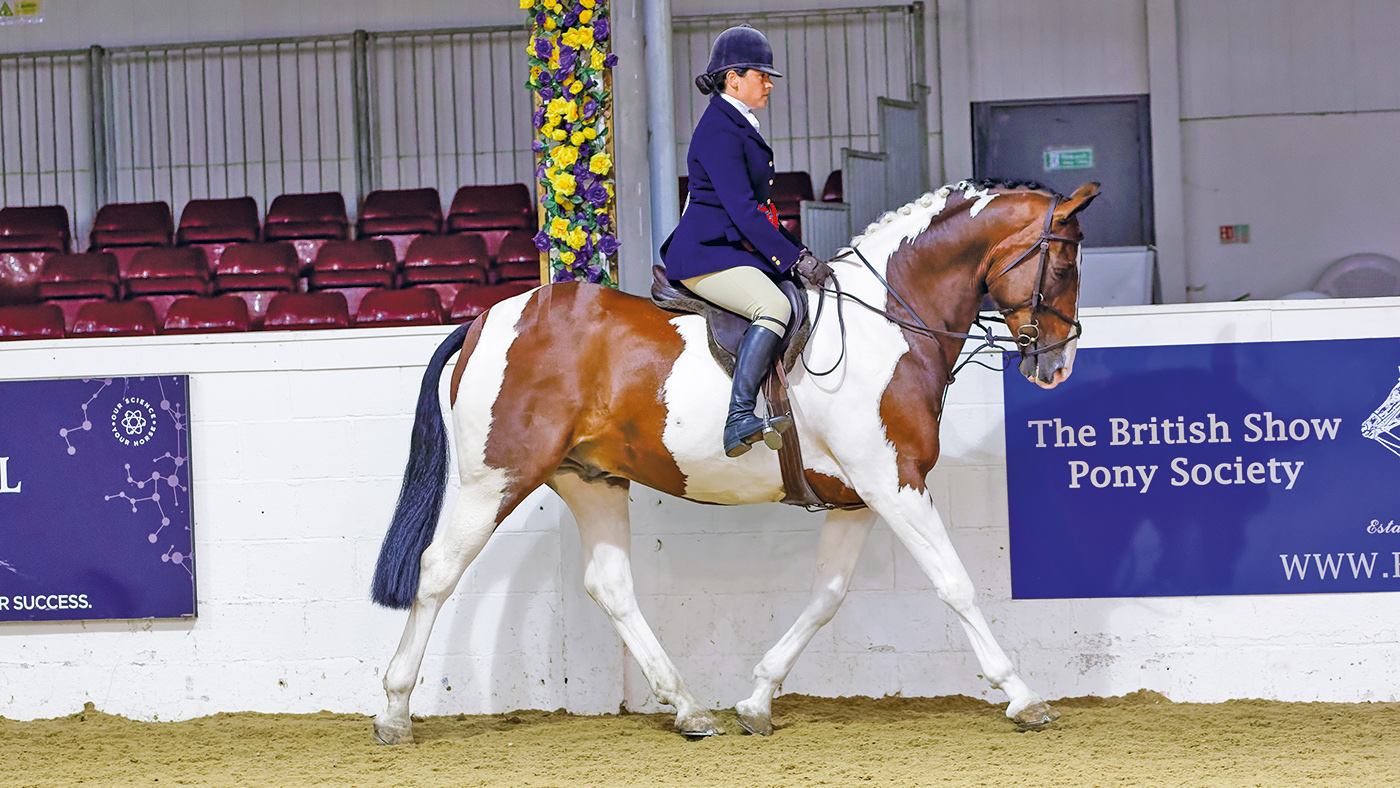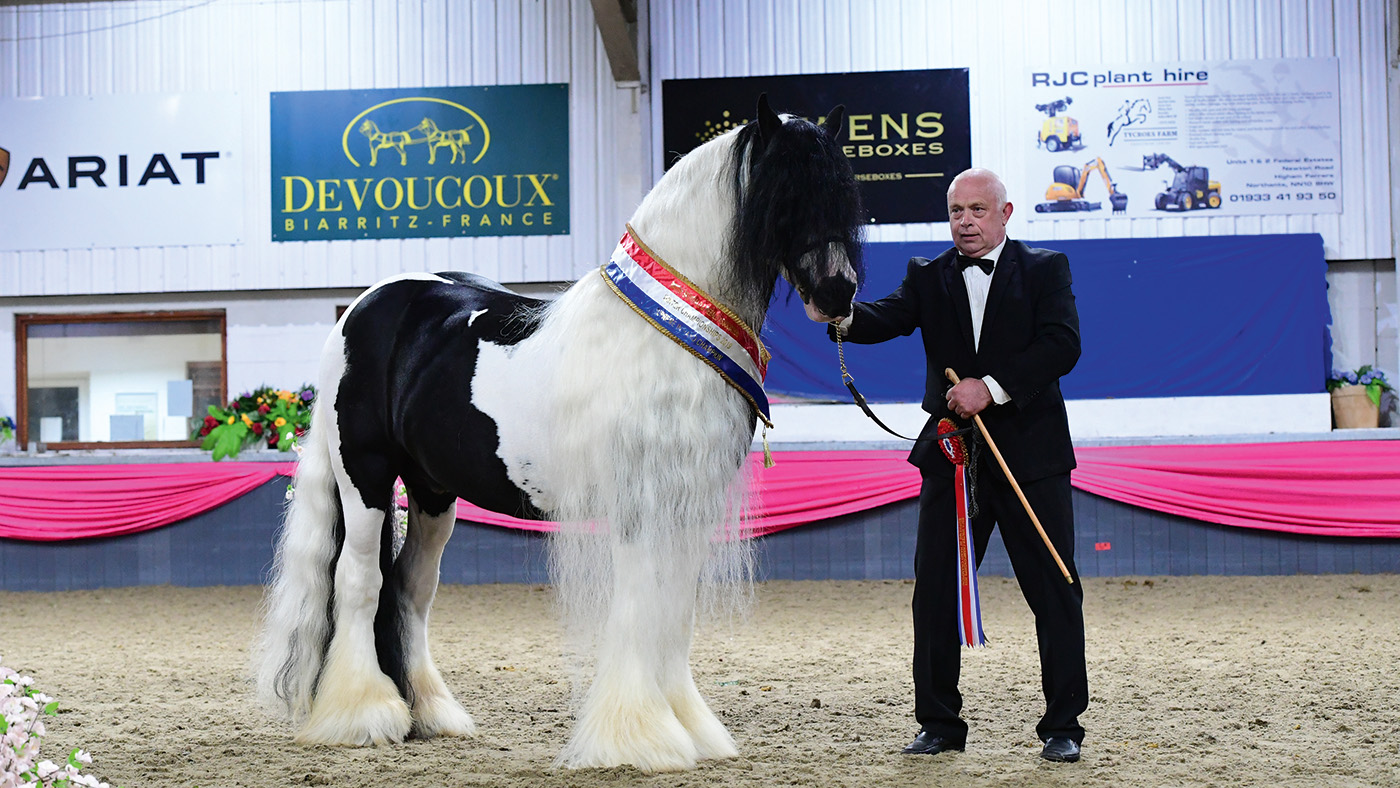Coloureds are one of the most hotly contested sections within showing, but this hasn’t always been the case. Alex Robinson looks at what’s led to this influx of fans and how you can impress in these classes
ONCE arguably the underdog of the show ring, a quality coloured – horse or pony, hairy or not – is a force to be reckoned with. Today, if you strive to win with your own patchy partner, you need to be on the money in both performance and turnout, and also ensure that the animal you’re sitting on ticks all the necessary type and conformation boxes.
It was back in 1988 when a group of 11 friends got together around a kitchen table and founded the British Skewbald and Piebald Association (BSPA) – one of the two main showing societies dedicated to coloureds – as a reaction to the growing number of enthusiasts.
“We felt there was a need for an umbrella to promote the interests of the coloured horse,” explains BSPA chair Lynda Lodge, who has been with the association since day one. The BSPA was initially run by a general council and a series of volunteers, known as regional team leaders, who put on shows in their areas at both local and county level.
“There was so much enthusiasm that we were soon able to put classes on at the higher levels,” Lynda continues. “Gradually, people realised that coloureds could be showstoppers just like any other animal.”
The other society, the Coloured Horse and Pony Society UK (CHAPS UK), was founded in 1983. Their aim from day dot has been to “promote the coloured horse and pony in all equestrian spheres”.
“Coloured showing obviously attracts a niche market,” says Caroline Hamilton, judge, breeder and current chair of CHAPS. “But it’s increased in popularity; coloureds are readily available and are easy to source for most people, especially the hairy ponies.
“The temperament of the coloured horse is another key factor; because of the genetic influence of the traditional cob, you don’t find many with an inherently bad temperament. Today, well-structured breeding programmes are in place – including our own grading system – but we owe a lot of gratitude to the traveller community who put a lot of time and effort into developing the coloured into what we know it as today.”

Caroline has witnessed coloured horse and pony showing develop into the classifications seen today. Currently, CHAPS coloured classes at county and Horse of the Year Show (HOYS) level are split into four sections – non-native horses and ponies (not exceeding 153cm) and traditional, native or cob horses and ponies (not exceeding 148cm).
“Initially, there was just one class,” continues Caroline. “The first coloured classes at HOYS were held in 1998 and there were just two classes; under and over 158cm. The hairies – of any height – then got their own class, with non-native ponies and horses also being split. We now have the four distinct sections.
“I’ve always believed there should be a separate class for hairies under 14.2hh; there are thousands of traditional coloured ponies bred intentionally to come in under this height. While you could always go out and find a decent 14.2hh black and white cob, once upon a time you would struggle to buy something of a similar stamp at 15.1hh. This is beginning to change as vanner and traditional horse breeding develops.
“Plaited ponies under CHAPS rules are limited to under 153cm to balance competitor numbers; there are few under-148cm ponies so it made sense to increase the height limit.”
COLOUREDS have had a presence at the Royal International (RIHS) for 20 years. Over the two decades, their place has grown so that coloured competitors now have a whole day – Tuesday – dedicated to the BSPA classes.
“We’ve been given umpteen opportunities which we’ve grabbed with both hands,” says Lynda. “Hickstead, and especially the late Roger Stack, have been highly supportive of coloureds at the RIHS over the years.”
Lynda feels the amateur constituency is largely responsible for the coloured’s increased visibility on the show circuit.
“Largely, the classes are made up of amateur riders,” she says. “They seem to provide a level playing field and amateurs feel they are on a more even footing. Historically, the ‘solid’ colour horse, such as the hack, hunter and riding horse, has been the producer’s ride. As the interest has increased and breeding has become more refined, the pros and their owners have gradually entered the coloured scene. Now, most professionals will run a coloured or two from their yard, but 10 years ago this was unheard of.
“The desire to improve from coloured owners, breeders and riders is something I don’t see as much in the other sectors. There is an enthusiasm and keenness which is catching.
“It’s exciting to be around. There is always something new and evolving, especially in terms of the multitude of unusual colours being seen in the show ring.”
BUT with high class numbers and improved quality comes a harder task for our judges.
“Judges have got their eyes in, too, and are throwing themselves into the diverse range of types,” says Lynda. “In other horse and pony classes, such as hunters, half the work is done for you; they’re all, hopefully, of the type before they enter the ring.
“The coloured can be any type and especially in the non-plaited sections, our judges are presented with natives, traditionals and hogged animals. You must be able to select the best of each type and be aware of how differently they are presented. In all, our judges have to be a lot more diverse and flexible.”
Show horse producer Vicky Smith agrees that judging coloureds comes with its own set of challenges.
“Really, they shouldn’t be any different to judge than any other class,” says Vicky, who has won the coloureds at HOYS on three different occasions, standing champion in 2016. “You have to ignore the colour and ask yourself what type it would be if it was black or bay. Many people are wrongly under the illusion that markings and colours matter, but it’s all about conformation and type as it would be in any other class.
“The unique aspect is judging so many types against each other; you could be assessing a variety of ridden animals, such as a first ridden against an open 15-hander, or a hack against a heavyweight hunter. Each is to be judged on its own merits.
“In the ride, you also need to mark how each animal performs in accordance to its type. I wouldn’t expect a riding horse to cover the ground as much as a hunter. A native pony will move and go differently to a traditional. Lots of the hairy ponies were bred to pull carts, so expecting them to demonstrate serpentines and walk to canter transitions like an open hunter pony isn’t necessary.
“Some of the plaited ponies would be expected to gallop on, others wouldn’t. This is where a judge’s knowledge and experience is essential. Coloured classes also give you a brilliant opportunity to play to your animal’s strengths.”

Vicky Smith riding Bart
While it’s imperative that judges know their type, Vicky also says that it’s the competitors’ responsibility to turn out accordingly:
“I see so many coloureds wearing plaited browbands when in reality the animal is more of a hunter in stamp,” she says. “Similarly, make sure you wear the right jacket for the type of horse. Make it clear to the judge, but also don’t be afraid to ask for their advice.”

Domino Bad Boy (Horse No 141), In-Hand Supreme Champion during the BSPA Festival of Showing and Winter Championships at The College Equestrian Centre in Keysoe near Bedford in Bedfordshire in the UK on 24th February 2019
Breeder and judge Cathy Wood has been on the CHAPS panel for over two decades. She judged at HOYS in 2013 when plaited horse victor Spiritus (Robert Walker) lifted the overall crown.
“The biggest change I’ve noticed over the years is that instead of coloured horses, they’ve become horses of colour first,” says Cathy. “The increased availability of homozygous stallions has meant more people selecting guaranteed colour as a priority and consequently we’ve lost some of the best influences – including that injection of quality and proper, flat bone, coming from the thoroughbred.
“While there are a few lovely homozygous stallions out there, including one or two super young British-bred ones, they are few and far between,” adds Cathy. “We are possibly prioritising colour over conformation, which isn’t good. While this loss of thoroughbred influence can be seen across other sections too, it’s amplified here as some people breed specifically for a colour.
“Overall the plaited horses and ponies are arguably the weaker sections as a whole. Although you will often find your champion here, the quality doesn’t travel down the line in the same way as in the hairies where there is more consistency. All that said, they are amazing sections to judge and are so well supported with some of the most enthusiastic exhibitors on the circuit.”
Ones to watch
Myspires Spirit Of Summer

THE four-year-old non-native mare by Sempers Spirit out of Equina B will be making her debut in ridden classes with owner Sophie Rawlings. Produced by Craig Elenor and Sara Parrott, “Summer” was supreme at the CHAPS summer show in 2020, her only outing of the year.
“She was backed over winter and she’s taken to the job really well,” says Sophie.
Fencers Gypsy King

MEGAN BAKER was gifted the yearling colt by her husband before he was even born. “Tyson” is by traditional coloured Hope King, out of Welsh section C Abercippyn Lady In Red and Megan has shown both ponies in the past.
“We showed Tyson’s half-sister to much success in-hand, so we hope to do the same with him, when we can find someone to keep up with him,” says Megan.
O’Toole

THE eight-year-old gelding has a new jockey in Jessica Penrose. The lightly shown traditional was bought from coloured specialist Michelle Cuerden in November.
“He doesn’t have much mileage as he was cut later in life,” says Jessica. “We’re currently in training to hopefully get out and enjoy the season.”
This feature is also available to read in this Thursday’s H&H magazine (8 April, 2021)
You may also be interested in…

Lowmoor Windsor: the characterful and prolific champion middleweight show horse *H&H Plus*

Horse & Hound’s 140th anniversary legends: Pretty Polly – the show pony who has left an extensive legacy

Pony make-up warning and new showing opportunities *H&H Plus*

Rebecca Penny: ‘Reputation is an important asset’ *H&H Plus*


